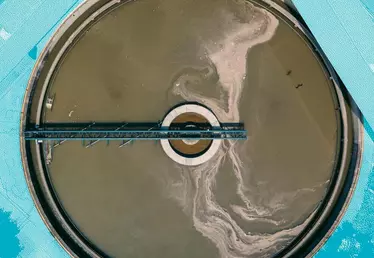

Hero banner custom title
Why doesn’t rain always replenish the water table?
4 min
From the surface to the water table, the journey of water is littered with obstacles.
The water table, which is filled by rainwater, constitutes our planet’s largest reservoir of potable water. Some 75% of water consumed by Europeans, 51% for Americans, and 85% of water in rural India comes from this underground water source. However, as counterintuitive as it may seem, rainfall does not always raise the water table… Find out more below.
Be in the right place...
To understand this phenomenon, let’s consider a simple example. Pour some water into a bucket filled with sand: it will absorb the water and nothing will drip out if you tip the bucket on its side. Below the soil, the water table works in the same way. “Sandy soils are great aquifers, since they retain water like a sponge, just like porous rocks such as limestone and chalk: water fills the empty spaces between the grains and remains captured there”, explains Jérôme Nicolas, Hydrogeologist at the Geological and Mining Research Bureau (BRGM), a French public institution that manages soil and subsoil resources and risks. On the other hand, soils like clay are not great aquifers: water can neither seep through this soil nor be stored there. Instead, it flows over this impermeable layer until it reaches a nearby stream. So in order for heavy rainfall to replenish the water table, it must first have a suitable subsoil geology.
…at the right time
In addition, the water table’s replenishment also depends on the season. In summer, soils are often very dry, which keeps water from seeping through with ease. High temperatures also encourage rapid evaporation of water. "Rainfall events during this time of year are often more intense than the rest of the year. Water runs over the ground to a stream more than it seeps into soils. Finally, plant life is also very active, and water is absorbed by plants before it can penetrate deep into the subsoil," says Jérôme Nicolas. Autumn and winter are thus key times of year for the water table. Lack of rain during these seasons is the main cause for concern, since it means that the water table will not have any other opportunity to restore its level. But summer rains do have one beneficial effect: they help water plants and crops to keep them from drawing on groundwater reserves.
In France, only 20 to 23% of annual rainfall seeps into the water table.
Estimating the percentage of rainfall that seeps deep into the ground remains complex and difficult to quantify. In France, it is estimated that on average only 20 to 23% of annual rainfall infiltrates deep into the ground. To enable companies and local authorities to forecast changes in groundwater levels, BRGM and Veolia have created PrédiNappe. This computerized tool makes it possible to monitor changes in groundwater to ensure a balance between needs and available resources. To increase these resources, we should try to optimize our water use... and give our planet enough time to refill the water table.











